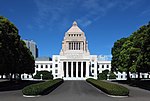The Kudan
Ambassadorial residencesDiplomatic missions in TokyoDiplomatic missions of the PhilippinesGovernment buildings completed in 1935Interlanguage link template existing link ... and 2 more
Japan–Philippines relationsNational Historical Landmarks of the Philippines

The Residence of the Philippine Ambassador to Tokyo, informally known as the Kudan (九段), is the official residence of the Philippine ambassador to Japan. It is located in 1-1-1 Fujimi, Chiyoda-ku, Tokyo, Japan. It is called the "crown jewel of Philippine foreign service" and became the first officially designated National Historical Landmark outside Philippine soil. Ambassador Jose Laurel V, the current Philippine ambassador to Japan, currently resides in the building.
Excerpt from the Wikipedia article The Kudan (License: CC BY-SA 3.0, Authors, Images).The Kudan
Mochinoki-zaka, Chiyoda
Geographical coordinates (GPS) Address External links Nearby Places Show on map
Geographical coordinates (GPS)
| Latitude | Longitude |
|---|---|
| N 35.696944444444 ° | E 139.74916666667 ° |
Address
九段
Mochinoki-zaka 1号
102-0071 Chiyoda
Japan
Open on Google Maps










